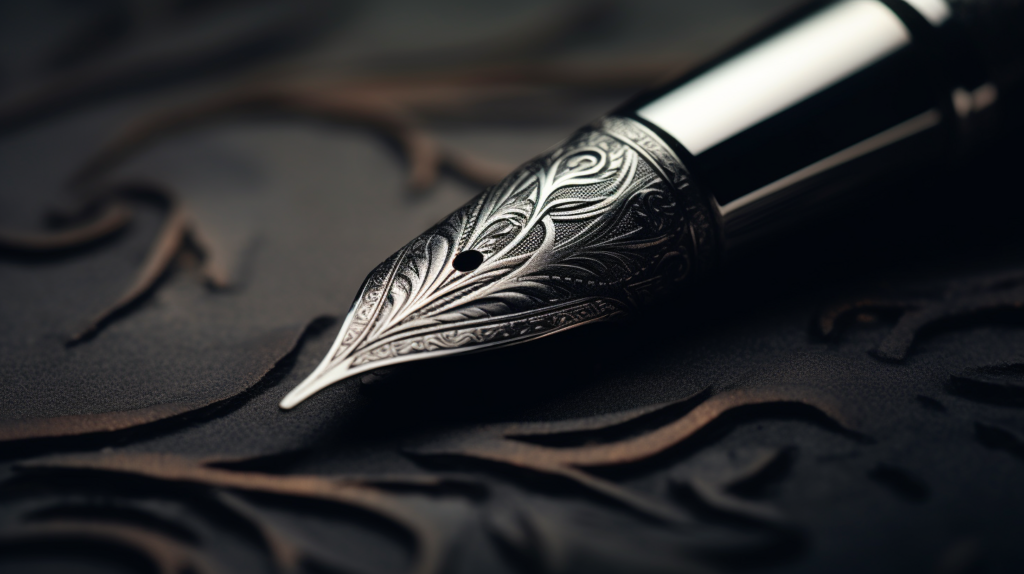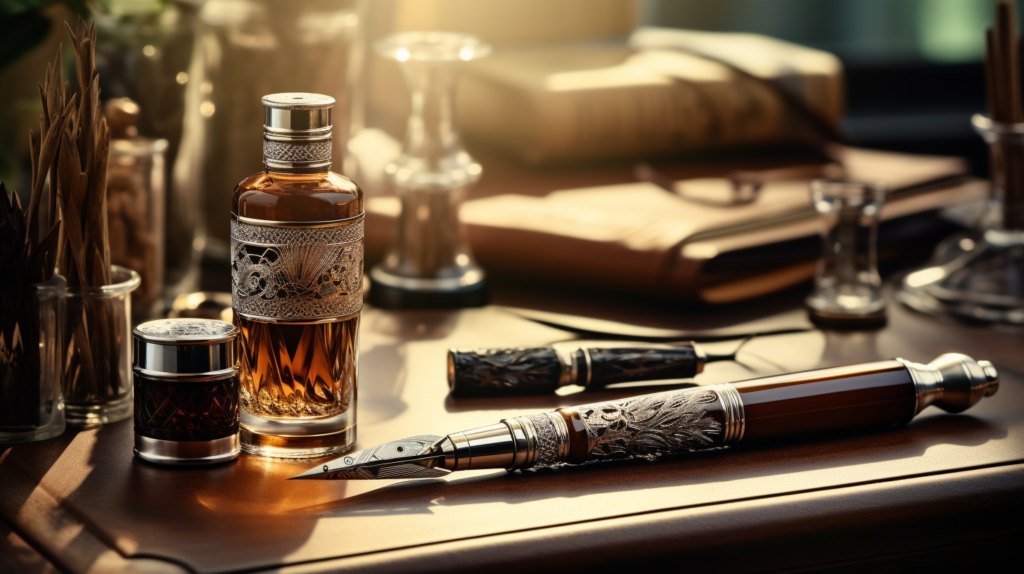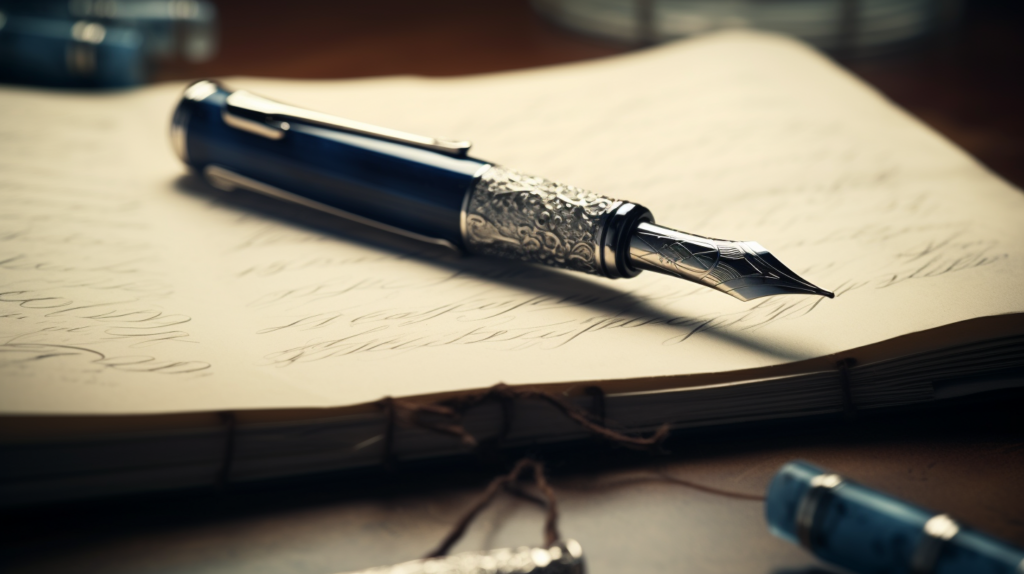
Interested in leveraging the elegance of fountain pens but unsure how they work? In this blog post we will cover exactly How Do Fountain Pens Work! Each year, millions discover the joy and prestige that comes with using these timeless writing instruments.
This post will demystify the complex mechanics behind fountain pen operation, from its unique anatomy to ink flow dynamics. Let’s dive into this fascinating world!
Anatomy of a Fountain Pen
The nib, feeder, section, ink reservoir, body, and cap are the key components that make up a fountain pen.

The Nib
The nib is the heart and soul of a fountain pen. It’s made from materials like gold, steel, or iridium and typically designed with two tines split down the middle by a narrow slit.
This allows ink to flow smoothly onto your paper as you write. The size and shape of the nib determine the thickness and style of your lines when writing—broad, medium, fine, or extra-fine are common grades.
Stub or italic options can add flair for calligraphy-style work too!
The Feeder
The feeder of a fountain pen holds a vital role in the process of ink delivery. It’s nestled under the nib and works as a conduit, carrying ink from the reservoir to the paper through capillary action.
Many beginners with new fountain pens may overlook this seemingly insignificant piece, but it definitely affects your overall writing experience.
A well-designed feeder ensures consistent flow of ink which can make or break your writing! Imagine writing an important document – you certainly wouldn’t want random blotches of ink spoiling your work.
Also, bear in mind that different feeders can alter how wet or dry a pen writes. This plays into personal preference when choosing fancy fountain pens for yourself.
The Section
The section of a fountain pen is the part where you grip when writing. It bridges the nib and the body of the pen, ensuring smooth ink flow from the reservoir to your paper. The design usually narrows down towards the nib for a comfortable grip during those long writing sessions! Whether a beginner with fountain pens or an expert, having knowledge about ‘the section’ helps in understanding how your favorite writing tool works.
The Ink Reservoir
The ink reservoir is where the magic happens in a fountain pen. It’s the part that holds the ink and supplies it to the nib for writing. Depending on the design of the pen, the ink reservoir can be in different forms.
Some pens have a built-in ink cartridge that you can replace when it runs out, while others use an internal piston mechanism or a converter to draw ink from a bottle. No matter which type you choose, having an ample supply of ink ensures smooth and continuous writing with your fountain pen.
The Body
The body of a fountain pen is the main housing that holds all the essential components together. It provides stability and structure to the pen, ensuring a comfortable grip for writing.
Made from various materials like plastic, resin, or metal, fountain pen bodies come in different designs and styles to suit individual preferences. The body also acts as a protective casing for the ink reservoir and prevents leakage when not in use.
With its sleek and elegant design, the body of a fountain pen adds an element of sophistication to your writing experience.
The Cap
The cap of a fountain pen serves an important purpose – it keeps the nib protected and prevents the ink from drying out. Made typically from metal or plastic, the cap fits securely over the nib and forms a seal to prevent evaporation.
It also helps to maintain the ink flow by creating a controlled environment inside the pen. When you’re not using your fountain pen, make sure to always put the cap back on to keep it in optimal condition and ready for your next writing session.
In addition, some caps have extra features like clips that allow you to easily attach your pen to pockets or notebooks, making them convenient for carrying around. The design of caps can vary greatly depending on the brand and model of fountain pen, offering different colors and finishes that add a touch of style to your writing instrument.
Ink Flow in a Fountain Pen: How Do Fountain Pens Work
Ink flow in a fountain pen is achieved through the combination of gravity and capillary action, working together to deliver a steady stream of ink onto the paper.

Gravity
Gravity plays a crucial role in the ink flow of a fountain pen. As you hold the pen upright, gravity causes the ink to flow from the ink reservoir down towards the nib. The force of gravity helps create pressure that pushes ink to the feed and eventually onto the tip of the nib.
This downward movement of ink is vital for consistent and smooth writing with a fountain pen. Without gravity, it would be challenging for the ink to reach and flow through all parts of the intricate feeding mechanism, resulting in disrupted writing performance.
Capillary Action
Capillary action is a key factor in how ink flows in a fountain pen. When you dip the nib of the pen into the ink, the tiny channels in the nib draw up and hold onto some of that ink.
This happens because of the interaction between two forces: cohesion and adhesion. Cohesion allows molecules within the liquid ink to stick together, creating a continuous flow. Adhesion causes these molecules to stick to other surfaces, like the walls of the nib’s channels.
As a result, when you put pen to paper, capillary action helps pull ink from inside the pen onto its tip and onto your writing surface with each stroke.
How they work together
The ink flow in a fountain pen is dependent on the combination of gravity and capillary action. Gravity helps to pull the ink down from the reservoir towards the nib, while capillary action draws the ink up through tiny channels in the feed and onto the tip of the nib.
These two forces work together seamlessly to ensure a constant and smooth flow of ink as you write. It’s this harmonious interaction between gravity and capillary action that makes fountain pens so unique and enjoyable to use.
Different Types of Fountain Pen Filling Mechanisms
There are several types of fountain pen filling mechanisms to choose from, including the piston converter, squeeze converter, and push button converter. Discover which one suits your needs best!
Piston Converter
The piston converter is a popular filling mechanism found in many fountain pens. It allows you to draw ink directly into the pen’s reservoir by twisting or turning a knob. To use it, simply submerge the nib of the pen into an ink bottle, twist the converter’s knob to expand the internal chamber, and then release it to fill up with ink.
This mechanism offers a convenient and mess-free way to refill your fountain pen without having to constantly buy cartridges or disposable converters. With a piston converter, you have more control over your ink choices and can enjoy a wider variety of colors and brands.
Squeeze Converter
To fill your fountain pen with ink using a squeeze converter, simply remove the converter from the pen and place the nib into a bottle of ink. Squeeze the empty converter to create a vacuum and then release it into the bottle, allowing it to fill up with ink.
Once filled, reattach the converter to your fountain pen and you’re ready to write! The squeeze converter is an easy and convenient way to refill your fountain pen without any mess or fuss.
Push Button Converter
A push button converter is a type of filling mechanism commonly found in fountain pens. Unlike other converters, which require twisting or squeezing to fill the pen with ink, the push button converter simplifies the process with just a simple press of a button.
When you want to refill your fountain pen, all you need to do is immerse the nib into an ink bottle and press down on the button located at the end of the converter. This action creates suction that draws the ink up into the reservoir of your pen.
The push button converter is convenient and easy to use, making it a popular choice among fountain pen enthusiasts who enjoy experimenting with different colors and types of ink without having to go through complicated refilling procedures.
What Makes Fountain Pens Special?
Fountain pens are special because of their unique design and the smooth writing experience they offer. Unlike ballpoint pens, fountain pens use liquid ink which flows onto the paper effortlessly.
This results in a more consistent and vibrant line quality that is highly sought after by writers, artists, and pen enthusiasts alike. Additionally, fountain pens can be refilled with different colors of ink, allowing for endless creative possibilities.
The weight and balance of a fountain pen also contribute to its appeal, providing a comfortable grip that reduces hand fatigue during long writing sessions. Overall, the elegance, precision, and versatility of fountain pens make them truly special tools for anyone who values fine writing instruments.

Tips for Using Fountain Pens
– Choose the right fountain pen based on your preferences and writing style.
Choosing the right pen
When selecting a fountain pen, keep in mind these key factors:
- Consider the weight and size of the pen to ensure a comfortable writing experience.
- Look for pens with nibs that match your preferred writing style, such as fine, medium, or broad.
- Decide on the filling mechanism that suits your needs, whether it’s a piston converter or a squeeze converter.
- Take into account your budget and choose a pen that offers good value for money.
- Think about the design and aesthetics of the pen, as it can add to the enjoyment of using it.
Proper grip and posture
To get the most out of your fountain pen, it’s important to have a proper grip and posture. Hold the pen between your thumb and index finger, making sure it rests on the pad of your middle finger for stability.
Avoid gripping too tightly, as this can cause fatigue and discomfort. Sit up straight with both feet flat on the ground, allowing your arm to move freely across the page. By maintaining a relaxed grip and good posture, you’ll be able to write comfortably and smoothly with your fountain pen.
When using a fountain pen, remember that it requires very little pressure to write. Let the weight of the pen do most of the work as you guide it across the paper. This will help prevent ink blobs or scratches on the page.
Maintaining and cleaning the pen
To keep your fountain pen in top condition and ensure optimal performance, you need to maintain and clean it regularly. Here are some tips for maintaining and cleaning your pen:
- Rinse the pen with clean water after each use.
- Use a soft cloth or tissue to gently wipe off any excess ink from the nib and section.
- To remove dried ink, soak the nib and feeder in warm water for a few minutes, then gently scrub with a soft toothbrush.
- Avoid using harsh chemicals or solvents to clean your pen, as they can damage the materials.
- If you’re not going to use your pen for an extended period, empty the ink reservoir and rinse it thoroughly. Store the pen in a cool, dry place.
- Regularly replace or refill the ink cartridge or converter according to the manufacturer’s instructions.
Writing techniques
To maximize your writing experience with a fountain pen, there are a few techniques to keep in mind. First, apply light and consistent pressure when writing to allow the ink to flow smoothly onto the paper.
Second, hold the pen at a 45-degree angle for optimal nib contact with the paper. This angle helps control ink flow and prevents scratchy or uneven lines. Lastly, practice smooth and fluid strokes by using your arm instead of just your fingers.
By incorporating these techniques into your writing, you’ll be able to fully enjoy the unique experience of using a fountain pen while creating beautiful handwriting.
Troubleshooting common issues
If you encounter any issues with your fountain pen, here are some common problems and their solutions:
- Ink skipping: Ensure that the nib is properly aligned and not clogged with dried ink. Clean the nib with warm water or use a pen flush solution.
- Ink flow issues: Check if the ink reservoir is empty or if there’s an air bubble blocking the flow. Prime the feed by gently tapping the pen on a piece of paper or twist the converter to expel any air.
- Hard starts: If the pen takes time to start writing, try priming the feed or adjusting the nib alignment. You can also try using different types of ink that have better flow properties.
- Leaking or burping ink: Make sure the converter or cartridge is securely in place and not loose. Avoid leaving your pen in extreme temperature changes that can cause expansion and contraction of air inside.
- Scratchy writing: This may be due to misaligned or damaged nib tines. Use a loupe or magnifying glass to inspect and gently realign them if necessary.
- Ink stains on fingers: Wipe excess ink off the nib before closing the cap, and be cautious when handling freshly filled pens.
- Pen won’t write at all: Check if there’s any blockage in the feed, clean it thoroughly with warm water, or consider flushing out old ink residues from previous fills.
Conclusion: How Do Fountain Pens Work
Understand how fountain pens work by learning about their anatomy, ink flow mechanisms, and what makes them special. Discover different types of filling mechanisms and gain tips on using fountain pens effectively.
With this knowledge, you’ll be well-equipped to explore the world of fountain pens and enjoy smooth writing experiences. Get ready to elevate your penmanship with these fancy yet functional tools!
FAQs
What is a fountain pen and how does it work?
A fountain pen is a type of pen that uses ink. The fountain pen works by releasing ink from a reservoir onto the paper through the action of gravity and capillary action.
How do I use a beginner’s fountain pen?
To use a beginner’s fountain pen, you fill it with ink (either by dipping or using cartridges), then write as normal, letting the nib glide over the page without applying too much pressure.
Are there any specific tips for writing with a fountain pen?
Yes, when writing with your new found passion -the Fountain Pen; remember to hold it at an angle instead of straight up and down, apply steady but light pressure on downstrokes only!
Is investing in fancy pens like these worth it?
Many people find writing with a premium quality instrument such as Fountain Pens are certainly worth it! They offer higher durability than regular pens since they’re often refillable which also makes them more environmentally friendly.




Leave a Reply
You must be logged in to post a comment.